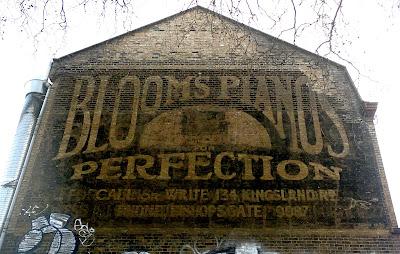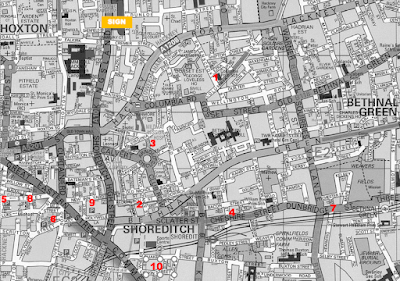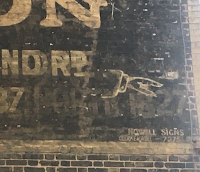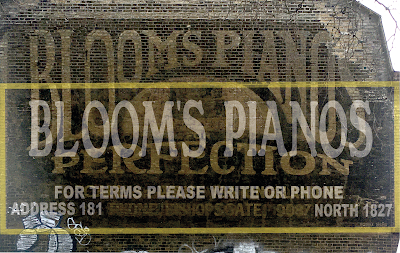I was in Shoreditch recently, wandering about admiring things, planning walking routes and generally enjoying the Winter sunshine. I decided, as I was close by, to go and visit an old friend, the hand-painted sign for Bloom’s pianos on the north side of the block that overlooks the front garden of The Museum of The Home.
 BLOOM’S PIANOS / illustration of upright piano / FOR PERFECTION CALL OR WRITE: 134 KINGSLAND RD.PHONE: BISHOPSGATE 9087
BLOOM’S PIANOS / illustration of upright piano / FOR PERFECTION CALL OR WRITE: 134 KINGSLAND RD.PHONE: BISHOPSGATE 9087
I stood there deciphering what I could see, making notes. When I got home, I tried to find out more info about its content, but what I did find was scant and posed more questions, and so began days of bloomin' research (see what I did there?!)...
This hand-painted sign clearly dates from the mid-1910s. Just check out the letterforms with the blobby serifs, the undulating cross bars on the E and F, the lovely kick on the R, the curves, arcs and stretches and, of course, that upright piano. Also, there is a direct telephone number here and exchanges of this kind did not become available until 1912, though I cannot, as yet, ascertain who the 9087 number belonged to.
Despite the directional at bottom right in the form of a manicule pointing to the front of the bulding, I can find no ref of any Blooms listed along this terrace. 134 Kingsland Rd is the address of the whole block from the museum to Cremer Street and comprises seven premises A-G. Intriguingly, the 1914 directory shows nothing for F, so there is a slim chance that a Bloom could have there for a short while. But I think it's more likely that this excellent advertising space, facing the traffic coming into London from the north, was simply used to advertise products made at nearby workshops, the sign being commissioned by an enterprising family of cabinet makers who made cases for pianofortes and had connections to someone in this block who could accept any correspondence on their behalf. This might well have been William Richard Mitchell, shopfitter, who was at D&E in 1914, or Clarke & Greenfield, glass mold makers, at G.

Bloom is a fairly common Jewish name and there have been many cabinet makers by this name living and working in the Bethnal Green and Shoreditch area. For instance, in 1899 there was Joseph Bloom at 54 Ravenscoft Street (1), a road that was mainly cabiinet makers at that time, and Nathan Bloom a short walk away at 29 Redchurch Street (2). Then, by 1910 Marks Bloom is at No.64 Ravenscroft St (1) and Joseph has moved into new premises at 5 Sunbury Works, Hocker St (3). To muddy the waters further, there was also Leckstein & Bloom in Cheshire Street (4) in 1910 with other workshops in Tabernacle Street (5) and Christina Street (6), and then in 1915 there’s Jacob Bloom in Dunbridge St (7) as well as Israel Bloom in Leonard Street (8) and Barnett Bloom in New Inn Yard (9). I have no idea if they were all related, but it's very possible.

Another idea (ooh, I am full of them!) could be that it was J.T.Howell who painted another similar-looking sign that includes an early C20th illustration, for Daniel Leakin’s valet and car hire service at 19 Wellington Row which is on the corner of Ravenscroft Street, coincidentally a couple of minutes' walk from a Bloom workshop. It's very likely that, just like the Bloom's sign in Kingsland Road, this was inititially an advertising site used to advertise services that were available close by. This is a small cottage-style terraced corner house so it's very doubtful a fleet of vehicles etc could be here. Until 1915 (just after I've lost track of Howell the signwriter) this corner location is shown as John Bates, coal dealer, who I think lived there and used it as his office. But let's park Daniel Leakin and his interwar motor haulage company and get back to the Blooms.
As I have hinted in the subject line, there is actually a second sign here which starts lower down, sort of halfway through the big letters. If you scroll back up to the top you'll notice that the lower two thirds are stronger in color than the upper part.

I have warped and stretched my original photo to better illustrate this. The tinted yellow box rule shows where the edges of this later sign are visible and in white I've added the letters I can ascertain thus far (though I have geussed the word 'please' at the centre).
At the bottom right there is a different telephone number from the earlier Bishopsgate one. In 1939 the NORTH 1827 number belonged to George William Every & Sons, gear cutters of 49 Thornhill Road, N1. Well, how bizarre – this is in Barnsbury, Islington, miles away from E2. Hmm, ponder ponder... perhaps, again, this was a correspondence address rather than a place to buy.
I then considered the number 181 at the bottom left corner and which road in the area might this apply to – my hunch was that it just had to be one of the main local shopping streets. It took me only five minutes to find Blooms House Furnishers (Isaac Bloom) at 181, 187 Caledonian Road in 1939 as well as opposite at No.198. So the missing/hard to decipher part in the center of the last line here must say Caledonian Road (and more). On another day, when the light is right, I will again return to the sign armed with a good camera lens and I hope to be able to update the image above.
The 1939 directory also shows that Nathan Bloom was still busy at his workshop at 29 Redchurch Street (1) and by this time had also taken on additional premises at 19-21. There’s also H&L Bloom listed at 3 Fountain Street which backs onto Sunbury Works (3) and surely must be the same family seeing as this was where Joseph was listed two decades previously. By this time there's also J. Bloom at 24A Calvin Street (10), a errace of workshops which still looks good today.
Note also that the smaller/later advertisement has no illustration. OK, so there was less space, and the inclusion of an illustration was expensive, but perhaps pianos, even the ones in beautifully-made wooden cabinets, were not as much of a selling point by the time this was painted, especially with domestic gramophone players becoming more affordable.
I've had a thought re the newer sign and why it is that shape... if you study that end wall today, or look again at my pics above, notice how the bricks at the Kingsland Rd side have been replaced – the uppermost front section of the wall has been rebuilt. It occured to me that this might possibly have been damaged during WWI Zeppelin raids – the red line on this map clearly shows that two airships passed quite close to 134 Kingsland Road in May 1915. It would be good to find out more and I'd love to see how the wall above the thinner sign would have appeared at that time the second sign was created and whether the visible elements of the first sign at the top were overpainted in black, perhaps.
Enough! I think I will stop now. I’m bloomin’ exhausted.
Any further info appreciated. Please use the comments box below or write to me @janeslondon via social media
